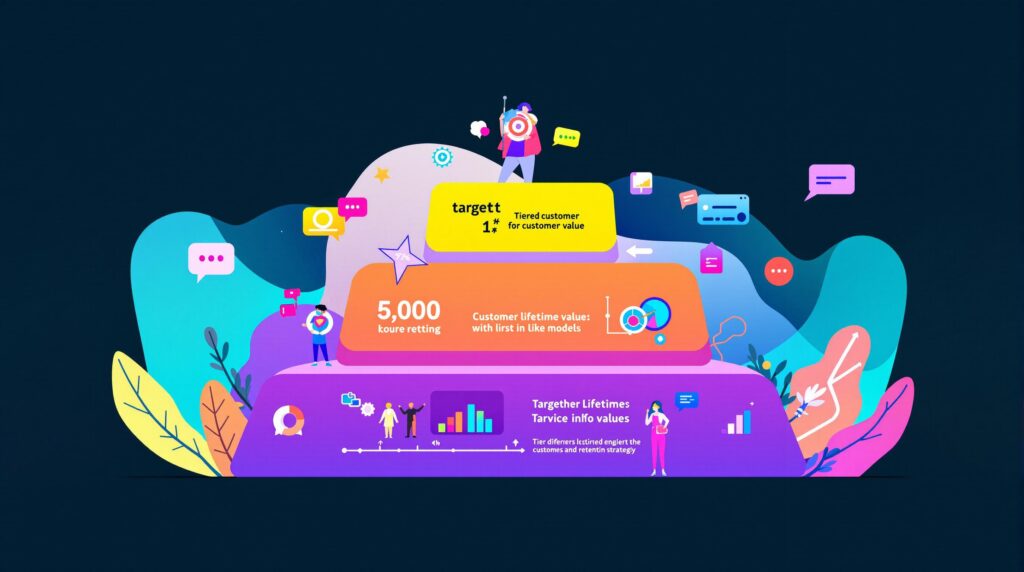Customer Lifetime Value (CLV) helps businesses understand the long-term value of their customers. By segmenting customers into tiers based on their CLV, companies can allocate resources effectively, personalize strategies, and boost retention. Here’s what you need to know:
-
What is CLV?
CLV measures the total value a customer brings over their lifetime. It’s calculated as:
CLV = (Average Revenue per Customer - Cost to Serve) / Churn Rate. -
Why Use Tiers?
Tiered models (e.g., Platinum, Gold, Silver) help group customers by value, enabling targeted strategies for each group. -
How to Use CLV in Tiers:
- Calculate base CLV.
- Segment customers into tiers based on CLV distribution.
- Define strategies for each tier:
- Top tiers: Premium perks and loyalty programs.
- Mid tiers: Upsell and engagement campaigns.
- Lower tiers: Activation plans and personalized offers.
-
Key Benefits:
- Efficient resource allocation.
- Improved retention for high-value customers.
- Data-driven marketing strategies.
How to keep it human within customer segmentation model
Breaking Down Customer Lifetime Value
Understanding Customer Lifetime Value (CLV) helps businesses make informed decisions about acquiring and keeping customers. Here’s how to calculate it and the main factors that impact it.
How to Calculate CLV
The formula for CLV is:
CLV = (Average Revenue per Customer - Cost to Serve) / Churn Rate
This calculation considers both earnings and service costs, offering a straightforward way to understand customer value.
For instance, if a business has an average order value of $25, a purchase frequency of 2.67, a gross margin of 41%, and a churn rate of 60%, the CLV would be $45.70 [4].
Factors That Impact CLV
Several elements influence CLV, including:
- Purchase Frequency: More frequent purchases mean a higher CLV.
- Average Order Value: Bigger orders directly increase customer value.
- Customer Retention: Lower churn rates boost CLV.
- Cost to Serve: Reducing service costs increases profitability.
Advanced models refine CLV by including factors like seasonal trends, customer cohorts, and behavioral patterns [3].
By understanding these factors, businesses can:
- Pinpoint ways to increase customer value
- Allocate marketing budgets more effectively
- Strengthen retention efforts for top-tier customers
- Cut costs without sacrificing service quality
Breaking down CLV provides actionable insights, helping businesses segment customers efficiently and focus resources on areas with the most impact. This metric also lays the groundwork for creating tiered customer value models tailored to different customer groups.
Creating Tiered Customer Value Models
Once you’ve calculated Customer Lifetime Value (CLV), the next step is to use it to create actionable customer segments through tiered models.
Why Use Tiered Models for Segmentation?
Tiered models help structure customer engagement by leveraging CLV insights. For example, Amperity‘s six-tier CLV model strikes a balance between simplicity and detail, making it easier to tailor strategies for different customer groups:
| Tier | Customer Segment | Percentile |
|---|---|---|
| Platinum | Top Value | Top 1% |
| Gold | High Value | 2-5% |
| Silver | Above Average | 6-10% |
| Bronze | Average | 11-25% |
| Medium | Moderate | 26-50% |
| Low | Basic | Bottom 50% |
This structure allows businesses to:
- Allocate resources efficiently to customers with the highest potential value.
- Personalize experiences based on the expectations of each tier.
- Control marketing costs by aligning spending with customer value.
- Boost retention with engagement strategies tailored to each segment.
How to Build Tiered Models with CLV
-
Start with Base CLV
Use the CLV formula outlined earlier as your foundation. -
Refine with Advanced Modeling
Apply techniques like Bayesian frameworks to improve predictions, especially for new customers or seasonal trends. -
Define Customer Tiers
Segment customers based on CLV distribution, considering factors like:- Purchase frequency
- Average order value
- Behavioral trends
- Service cost differences
-
Set Clear Thresholds
Use percentile ranges or specific CLV values to define the boundaries of each tier. -
Create Strategies for Each Tier
Develop targeted approaches for every segment:- Top tiers (Platinum, Gold): Offer premium services and loyalty programs.
- Mid tiers (Silver, Bronze): Focus on growth and engagement efforts.
- Lower tiers (Medium, Low): Implement activation plans and ways to increase value.
Once your tiered model is ready, you can use it to gain predictive insights and refine your marketing strategies.
sbb-itb-2ec70df
Using CLV in Tiered Models
This section explains how to predict Customer Lifetime Value (CLV) effectively, align marketing efforts with customer value tiers, and apply practical examples for better segmentation.
Techniques for Predicting CLV
Advanced statistical models, such as Hierarchical Bayesian frameworks, are particularly useful for improving CLV predictions. These models take into account factors like seasonality and cohort differences, allowing businesses to analyze both individual customer behavior and broader trends. They work well for:
- New customer segments with minimal historical data
- Seasonal businesses with fluctuating purchase patterns
- Small cohorts that require consistent predictions
Once you have reliable CLV predictions, these insights can guide the development of tailored strategies for each customer tier.
Marketing Strategies Based on Value
The goal is to maximize customer value by creating strategies that move customers to higher tiers while keeping top-tier customers engaged and loyal.
| Tier Level | Strategic Focus | Key Actions |
|---|---|---|
| Top Tier | Value Retention | Offer premium services, exclusive perks, and personal account management. |
| Mid Tier | Value Growth | Run targeted upsell campaigns, loyalty programs, and engagement activities. |
| Lower Tier | Value Activation | Provide beginner guides, free trials, and personalized recommendations. |
These strategies are most effective when backed by data-driven segmentation, as illustrated in the examples below.
Examples of CLV in Segmentation
Data plays a crucial role in creating effective CLV-based segmentation. Here’s how to approach it:
1. Purchase Behavior Analysis
Examine patterns in:
- Average order value
- Purchase frequency
- Exploration of different product categories
- Interaction with specific promotions
2. Value Migration Tracking
Track how customers move between tiers by analyzing:
- Upgrade rates from lower to higher tiers
- Time spent in each tier
- Factors influencing tier upgrades or downgrades
3. Performance Measurement
Measure success with metrics like:
- Retention rates for each tier
- Revenue growth within specific segments
- Conversion rates as customers move between tiers
The success of tiered CLV models relies on continuously analyzing and refining these strategies. Regularly reviewing performance metrics and making data-informed adjustments ensures long-term customer value management.
Summary and Next Steps
Key Points to Remember
When implementing CLV in tiered models, focus on precise data and ongoing improvements. Here are the main components that contribute to effective CLV-based segmentation:
| Component | Focus Area | Impact on Business |
|---|---|---|
| Data Analytics | Accurate CLV calculation and forecasting | Helps assess customer value effectively |
| Segmentation Strategy | Grouping customers based on value | Improves targeting and resource use |
| Performance Monitoring | Tracking metrics and analyzing results | Ensures strategies deliver results and ROI |
Mastering these elements allows businesses to make smarter decisions about customer relationships and marketing efforts. By using these strategies, companies can fine-tune their CLV-based segmentation for better outcomes.
What to Do Next
Here’s how to build on these strategies and improve your segmentation approach:
Refine Analytics and Deliver Value
Leverage advanced predictive tools to better understand customer behavior and deliver targeted benefits, such as:
- Customized offers and recommendations
- Prioritized customer support
- Exclusive perks for different tiers
Improve Performance Tracking
Concentrate on metrics that directly influence your segmentation success:
- Retention rates within each tier
- Revenue growth across customer groups
- Movement of customers between tiers
For businesses looking to elevate their approach, partnering with performance marketing agencies can bring expertise in areas like data analysis and customer journey mapping. These collaborations can enhance segmentation strategies and boost marketing ROI through informed decisions [2][4].
The effectiveness of your tiered model relies on consistently applying these methods and staying adaptable to shifts in customer behavior and market trends. Regularly reviewing and adjusting your approach ensures sustained success in managing customer value.
More Resources
If you’re working on a CLV-based tiered model, there are some tools and services that can help streamline the process and improve your business strategy.
Growth-onomics: Marketing Solutions for Growth

Growth-onomics offers services rooted in data analysis, focusing on areas like customer journey mapping and performance marketing. These services align well with CLV-based segmentation efforts. Here’s how their offerings can support your goals:
| Service Area | How It Supports CLV Implementation |
|---|---|
| Customer Journey Mapping | Pinpoints key touchpoints that drive value |
| Data Analytics | Provides actionable insights for CLV |
| Performance Marketing | Facilitates targeted campaigns for specific tiers |
| UX Optimization | Helps retain and maximize customer value |
Key Resources for CLV Modeling
If you’re looking to take your CLV modeling to the next level, consider these standout resources:
- Advanced Analytics Platforms: Amperity’s pCLV framework allows for precise segmentation and personalization by using advanced analytics. This tool is designed to create dynamic, value-based customer groups [1].
- Statistical Modeling Resources: PyMC Labs uses Bayesian models to tackle challenges like seasonality and small cohort predictions, which can improve the accuracy of your CLV calculations [3].
- Value Management Frameworks: Ibbaka focuses on connecting customer value creation with CLV growth. Their actionable frameworks are designed to enhance segmentation strategies [2].
These tools and frameworks can enhance your tiered CLV models by providing deeper insights and actionable strategies, helping you refine your approach and uncover new growth opportunities.
FAQs
What is CLV segmentation?
CLV segmentation involves grouping customers based on their predicted total value over time, which includes both past purchases and future potential. This approach helps businesses align their strategies with customer value, ensuring a more tailored and effective approach.
Typically, tiered models like the Platinum-to-Low framework are used to classify customers by value. The success of these models depends on factors like purchase habits, engagement levels, cost to serve, and churn risk.
"The key to growing customer lifetime value is to grow value to customer (V2C)." – Ibbaka [2]
This quote highlights the importance of focusing on what customers truly value. Advanced techniques, such as Bayesian models, can make segmentation even more precise by accounting for patterns like seasonal trends and group-specific behaviors.
Here’s how CLV segmentation can benefit businesses:
- Personalized Marketing: Develop marketing campaigns that resonate with different customer segments.
- Efficient Resource Allocation: Direct resources where they’ll have the most impact.
- Retention Strategies: Create targeted plans to keep high-value customers engaged.
- Customer Service Optimization: Adjust service levels based on customer tiers.
To get the most out of CLV segmentation, businesses should regularly update their models to reflect new data and evolving customer behaviors. This ensures strategies stay relevant and impactful, helping businesses maximize customer value and maintain growth over time.









